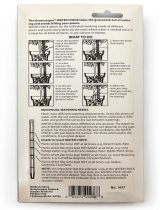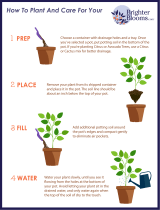Page is loading ...

HOW TO TEST FOR MOISTURE
1. At the start of every moisture reading session, use the special enclosed pad to
gently wipe the entire probe 2-3 times. Be careful not to polish the chrome
portion of the probe. Clean only the top.
2. Insert the probe, vertically if possible, into the pot half way between the edge
of the container and the plant stem. The depth of penetration will be influenced
by the size of the container. Probe deeper in a large pot, shallower in a small
one. A good rule of thumb is to probe about 1/2 to 2/3 of the way down from
the surface. For very large containers (over 12" in diameter) place the probe
closer to the stem (about 1/3 of the way from the stem to the edge of
pot.) While pushing the probe into the soil you may note that the meter reading
varies as the probe moves downward. This is because the moisture conditions
are not uniform. Certain types of soil have a tendency to create moisture
pockets, which might give you a false high reading in one small area of the soil.
We recommend you take at least two readings in order to confirm your findings.
(Note: probing aerates the soil, which is good for the plant.)
3. Note your meter reading.
4. Remove the probe from the soil by pulling the probe handle, not the wire.
Tugging the wire may result in a malfunction.
5. Wipe the probe completely clean with a soft cloth or tissue before taking
another reading or when finished. Important: The meter is designed and
constructed for test readings. The probe should not be left in contact with
soil for extended periods of time.
INTERPRETING YOUR READINGS
1. The numbers from 1 to 10 signify increasing soil moisture and plants cannot
tolerate either extreme for long. In the table provided, plants are listed
alphabetically by their popular names. Check the name of the plant being tested,
and look at the guide number listed in the column headed MOISTURE. If the
meter reading you received is higher than the guide number, DO NOT WATER. If
the number is the same or lower, water as directed.
Example: You are checking a Dumb Cane (Dieffenbachia). The meter reads 4, the
guide number is 1. You do not water!
2. The asterisks in the table indicate how often each plant likes water.
It is important to adhere to the frequency intervals.
* Check once a week ** Check every 4 to 5 days *** Check every 3 days
3. Special Watering Needs are marked with Roman numerals. They indicate:
HELPFUL TIPS WHEN USING THE WATERING GUIDE
1. Pot Size: Small pots dry out faster than large ones, so plants in small
pots may need to be checked and watered more frequently.
2. Type of Pot: Soil in clay pots dries out faster than soil in plastic
containers because baked clay is more porous.
3. Light: Plants in full sunlight dry out faster and use more water than
those in partial sunlight or indirect light.
4. Location: Plants close to a radiator or heater will dry out more quickly.
5. Overwatering: This term refers to an excessive frequency of watering,
not to the amount of water given. The result of overwatering is,
inevitably, rootrot.
6. Cacti and Succulents: These plants store water and require less
attention than other plants. From March to September, do not allow
the soil to dry out. Water when the meter reads 3. From October to
February (dormant period) water moderately every 2–3 weeks, just
enough to prevent shriveling. Always water with tepid water. Cold
water can severely shock plants.
If you have any questions or difficulties when using the meter, please contact Luster Leaf at
[email protected] or 800-327-4635. Please do not return your meter to your place of
purchase until speaking with us.
Luster Leaf Products, Inc.
Woodstock, Illinois 60098
I. Spray foliage daily
II. Never let soil dry out
III. Keep soil moist but never soggy
IV. Keep soil wet at all times
V. Allow soil to dry between watering
VI. Soil should remain dry 4–5 days
VII. Reduce watering during the plant‘s
dormant period
VIII. Water from beneath (in saucer).
Never wet foliage

AFRICAN VIOLET 3 **
ALOE 1 *
AMARYLLIS 3 **
ANTHURIUM 8 *** I
ARALIA 4 **
ARROWHEAD VINE 4 **
ASPARAGUS FERN 6 ** III
AZALEA 8 *** II
BAMBOO PLANT 4 **
BABY‘S TEARS 6 **
BAY TREE 6 ** I
BEGONIA REX 6 ** VI
BEGONIA 7 *** III
BIRD OF PARADISE 3 *
BILLBERGIA 6 *** I
BLACK-EYED SUSAN 4 ** III
BLOODLEAF 7 *** III
BLUE AFRICAN LILY 7 **
BOSTON FERN 6 **
BOTTLEBRUSH PLANT 6 **
BOUGAINVILLES 8 *** II
BROWAILIA F 3 *
BUDDIST PINE 7 **
BURRO‘S TAIL 3 ***
BUXUS 4 **
BUTTERFLY FLOWER 8 *** II
CALADIUM 7 ** III
CALCEOLARIA 1 *
CALLA LILY 7 *** VII
CAMELLIA 7 *** I
CAPE COWSLIP 7 **
CAPE IVY 1 *
CARDINAL FLOWER 1 *
CAST IRON PLANT 3 *
CASTOR OIL PLANT 4 **
CENTURY PLANT 1 *
CEROPEGIA 1 *
CHENILLE PLANT 6 *** I
CHINESE EVERGREEN 4 **
CHRISTMAS CACTUS 6 ** VII
CHRISTMAS PEPPER 7 *** I, III
CHRYSANTHEMUM 6 **
CINERARIA 4 **
CITRUS 1 *
CLERODENDRUM 7 ***
COFFEE PLANT 7 *** III
COLEUS 6 **
COLUMNES 7 *** I
COPPERLEAF 6 *** I
CORAL BERRY 7 *** I, III
CORN PLANT 7 ***
CREEPING MOSS 7 ***
CROSSANDRA 7 *** I
CROTON 7 **
CROWN OF THORNS 3 *
CRYPTANTYHUS 1 **
CUPID’S BOWER 6 **
CYCLAMEN 7 *** VIII
DEVIL‘S IVY 4 **
DIPLADENIA 1 * VI
DRACAENA (ALL) 7 ***
DUMB CANE 1 * VI
EASTER LILY 4 **
ECHEVERIA 1 *
EGYPTIAN STAR CLUSTER 7 **
EUONYMUS 1 * VI
FAT-HEADED LIZZIE 4 ** I
FERNS 6 *** I
FIGS, CREEPING 7 *** I
FIGS, FIDDLE LEAF 1 * VI
FIGS, WEEPING 4 **
FINGERNAIL PLANT 7 **
FIRECRACKER PLANT 7 ** II
FLAME OF THE WOODS 7 **
FLAMING KATY 1 * VI
FLOWERING MAPLE 7 ***
FRIENDSHIP PLANT 6 *
FUCHSIA 7 *** I
GARDENIA 8 *** I, II
GERANIUM 1 ** VI
GLORY LILY 4 **
GLOXINIA 7 ** VIII
GOLD-DUST PLANT 1 *
GRAPE IVY 4 ** VI
HEDERA IVY 6 **
HELIOTROPE 7 **
HEN-AND-CHICKEN 1 *
HIBISCUS 4 *
HYACINTH 8 *** III,VI
IMPATIENS WALLERANIA 7 ** VI
INCH PLANT 1 ** VI
JACARANDA 6 ** I
JADE PLANT 1 * VI
JACOBINIA 7 ***
JAPANESE SEDGE 7 *** III
JASMINE 7 ***
JASMINE PLANT 8 *** I
JELLY BEAN PLANT 1 *
JERUSALEM CHERRY 3 **
JESSAMINE 7 ***
KALANCHOE 1 * VI
KAFIR LILY 1 * VI
KANGAROO THORN 6 **
KENTIA PALM 6 **
LADY PALM 8 **
LANTANA 1 * VI
LIPSTICK VINE 7 **
LUCKY CLOVER 1 *
MAIDENHAIR FERN 6 *** III
MONSTERA 4 **
MOSAIC PLANT 7 **
MOSSES-IN-THE-CRADLE 7 ** III
MYRTLE 1 *
NARCISSUS 7 **
NASTURTIUM 7 **
NATAL PLUM 6 **
NICODEMIA (INDOOR OAK) 4 *
NICOTIANA 7 **
NORFOLK ISLAND PINE 4 **
OLEANDER 7 **
ORCHID 1 ** VI
PAINTERS PALETTE 8 **
PANDA PLANT 1 * VI
PARASOL PLANT 4 * I
PARLOUR PLANT 7 **
PASSION FLOWER 7 *** III
PEACE LILY 8 *** I
PEPEROMIA 1 **
PHILODENDRON 4 *
PIGGYBACK PLANT 6 ** III
PIGMY DATE PALM 8 *** VII
PILES (ALUMINUM PLANT) 6 **
PLUME FLOWER 7 ** III
POINSETTIA 1 * VI
POLYSCIAS 6 **
PONY TAIL 1 *
PRAYER PLANT 7 ** I
PRIMULA 7 ** III
RABBIT‘S FOOT FERN 7 **
RUBBER PLANT 4 *
SENSITIVE PLANT 7 *** I
SENTRY PALM 6 **
SHRIMP PLANT 1 * VI
SIDERASIS 1 *
SILK OAK 4 *
SNAKE PLANT 1 * VI
SNAKESKIN PLANT 4 ** I
SPIDER PLANT 7 **
STAR-OF-BETHLEHAM 7 **
STRAWBERRY GERANIUM 1 **
SUGAR ALMOND PLANT 1 * VI
SWEDISH IVY 4 **
SWEET FLAG 8 *** IV
TABLE FERN 8 **
TEMPLE BELLS 7 **
TILLANDSIA 7 **
UMBRELLA PLANT 10 ***
UMBRELLA TREE 1 ** VI
VASE PLANT 7 **
VELVET PLANT 7 ** I
VELTHEIMIA 7 ***
VENUS FLYTRAP 10 **
VERBENA 1 *
VIOLET FLAME 7 **
VRIESIA 1 **
WANDERING JEW 1 * VI
WAX PLANT 4 * I
WOOD-ROSE 6 *** I
YESTERDAY, TODAY, TOMORROW
6 **
ZERBRA PLANT 7 ** VII
PLANT MOISTURE FREQUENCY SPECIAL NEEDS
PLANT MOISTURE FREQUENCY SPECIAL NEEDS
WATERING AND SPECIAL NEEDS GUIDE
/



